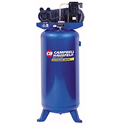|
tech
jeepfan.com
Guide to a Jeeper's Garage
Big Tools
Air
Compressors

Most of us know
the importance of owning a quality air compressor for our
garage. Picking the correct air compressor is
something usually overlooked when selecting a product.
The Wrong Acronyms
Horse Power (HP)
In the past, most people measured an air compressor by
horsepower (HP). The concept is simple, but it has a major
flaw.
Consider two race cars. One car has a 100-HP engine. The
other has a 120-HP engine. The car with the more powerful
engine doesn’t always go the fastest. There are numerous
other factors influencing how fast the car will go.
The same goes with air compressors. A 6-HP air compressor
isn’t guaranteed to perform better than a 5-HP air
compressor. In fact, a recent class-action lawsuit recently
forced several manufacturers to change how they promote
their products.
Pounds Per Square Inch (PSI)
Another consideration when purchasing a new air compressor
is pounds-per-square inch (PSI). The vast majority of air
tools require 90 PSI to operate. Most air compressors
produce at least 90 PSI. The extra pressure does little to
improve the machine’s performance.
The Right Acronym
An air tool requires air flow to work. Think of a
windmill. A slight breeze lacks the power to turn the
blades. However, a hurricane-force wind can generate
substantial power. Some air tools consume more air
than others. Impact wrenches and blow guns take short bursts
of air while sandblasters and sanders need massive gusts.
So, you basically want to know how fast the air comes out of
the compressor. The air flow is measured in Cubic Feet
Per Minute (CFM). The greater the flow -- the greater
the power. You simply select an air compressor that
exceeds the CFM of your most powerful air tool. If the flow
isn’t strong enough, the air tool simply won’t perform
properly.
The chart below quickly summarizes the average CFM rating
for the most popular air tools. For example, if you want to
use a sander, you’ll need an air compressor that produces AT
LEAST 6-13 CFM.

Impact Wrench 2-5 CFM |

Sand Blaster 6-10 CFM |

Sander 6-13 CFM |

Spray Gun 2-4 CFM |
sources:
Grainger, Sears
Types of Air
Compressors
Pump Types
Piston, Rotary
Vane, Lubricated and Oil Free. The piston type pumps
and usually belt driven and internally lubricated.
They require oil changes after a certain amount of usage.
Direct drive rotary types usually can deliver higher air
efficiency but generally make more noise.
Motor Types
120V and 240V,
Higher voltage compressors can usually make more efficient
use of power.
Tank Sizes
Tank sizes are
generally stated in US gallons. For example, 30 gallon is a
common tank size. So the question remains, how large a tank
do I need? First of all, don't confuse a large tank with
more run time for your air tools. If you use your impact
intermittently, a small tank is fine. However if you have
need for continuous use, you will need a larger tank with
big enough pump and motor. If the pump and motor are
powerful enough, you shouldn't run out of air. You can save
some dollars by purchasing an air compressor with a large
tank and smaller motor for intermittent use. If you need to
run a 1" impact wrench (about 20 CFM) intermittently, and
have a small compressor with a large tank, you might have
enough air stored in the tank to do the job. However, if you
are constantly running your air tool, you will need to
invest in a more powerful air compressor to do the job.
Vertical,
Horizontal, and Portability
A vertical air
compressor usually is stationary and takes less storage. A
horizontal air compressor is more portable and can be moved
from project to project. The style you choose from is
dependent on what your needs are with your air tools and
different projects. When selecting an air compressor
you should keep these different attributes in mind. The two
main things you should remember are what type of air tools
you will be using and the frequency that you will be using
them. If you keep those two things in mind, you should be
able to distinguish what features you need in an air
compressor and pick the right one for you.
Popular Air Compressor Manufacturers and Resellers

Sears
Campbell Hausfield
Ingersoll
Rand
Coleman
Dewalt
Porter
Cable
Ridgid
jeepfan.com Guide to a Jeeper's Garage
main page
|